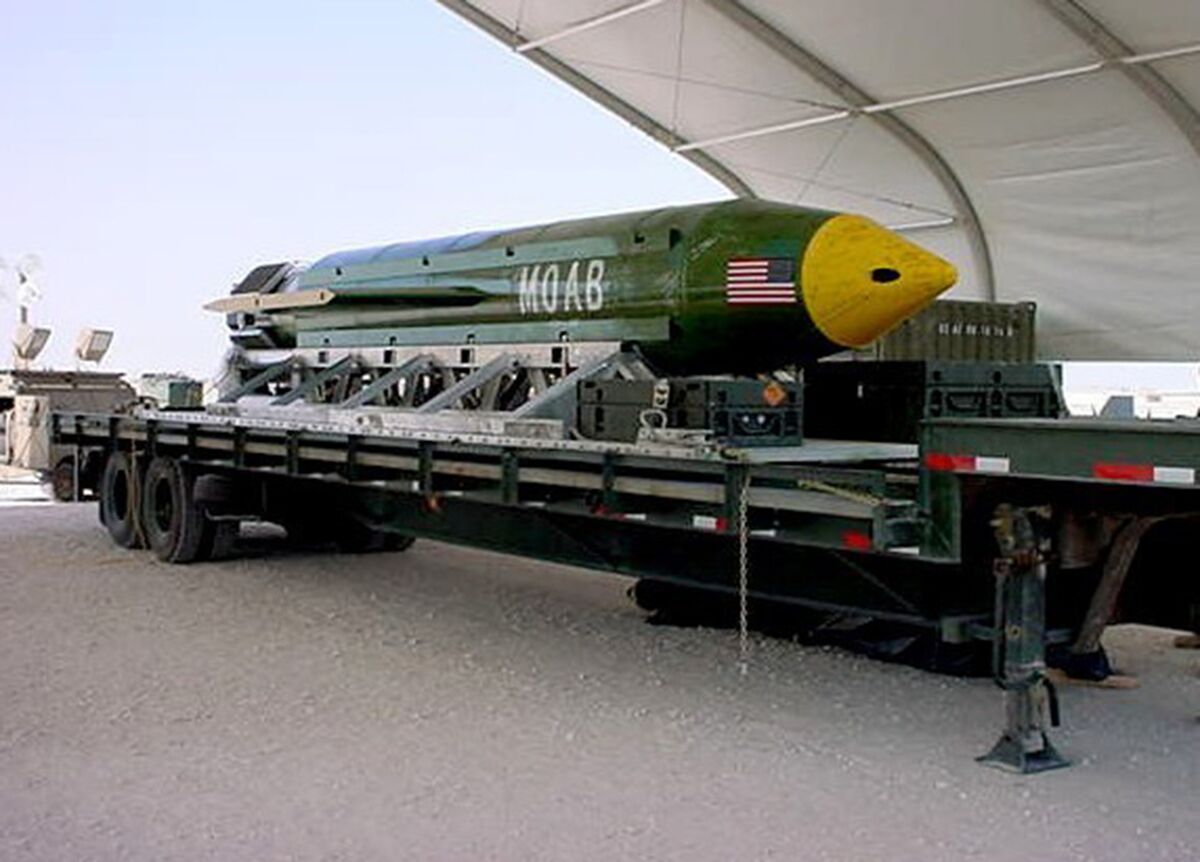
A U.S. airstrike with the military’s largest non-nuclear bomb killed at least 36 militants in an attack on Islamic State positions in Afghanistan while also triggering a rift among some of the country’s current and former officials.
The death toll was given Friday by Dawlat Waziri, an Afghan Defense Ministry spokesman, after the raid the previous night. The Massive Ordnance Air Blast bomb was dropped to destroy a series of caves and tunnels used by the terrorists.
“This was the right weapon against the right target,” General John Nicholson, the commander of U.S. forces in Afghanistan, told reporters Friday. “We have U.S. forces at the site and we see no evidence of civilian casualties nor have there been reports.”
Nicholson added that the strike “demonstrates the commitment of Afghan forces, Afghan government and U.S. partners to defeat” Islamic State.
The attack marked the first combat use of the so-called MOAB, a weapon so big that it’s rolled out the back of a cargo aircraft instead of being carried in a bomber’s internal bay or slung beneath the wings or fuselage. But the strike drew both support and criticism in a country long ravaged by fighting.
In posts on Twitter, the office of Afghan President Ashraf Ghani reiterated comments by U.S. officials, saying the raid was to support Afghan and U.S. forces against Islamic State in the Achin district of eastern Nangarhar province and efforts were made to minimize civilian deaths.
His predecessor, Hamid Karzai, strongly condemned the bombing.
“This is not the war on terror but the inhuman and most brutal misuse of our country as testing ground for new and dangerous weapons,” Karzai, the leader of Afghanistan from 2001 to 2014, wrote on Twitter. “It is upon us, Afghans, to stop the #USA.”
Afghanistan’s ambassador to Pakistan, Omar Zakhilwal, also protested the U.S. attack, breaking ranks with Ghani.
“I find the use of the largest non-nuclear bomb, the so called ‘mother of all bombs,’ on our soil reprehensible and counterproductive,” Zakhilwal said Friday on Twitter. “If big bombs were the solution we would be the most secure place on earth today.”
Asked Thursday in Washington whether he authorized the strike, President Donald Trump told reporters at the White House, “We have the greatest military in the world and they’ve done a job, as usual. We have given them total authorization and that’s what they’re doing.”
More about the giant bomb the U.S. used -- a QuickTake Q&A
The action came a week after Trump authorized missile strikes against Syria for a chemical weapons attack on civilians. It also coincides with rising concern that North Korea may conduct another nuclear test or missile launch. Trump has vowed that the U.S. will act to stop North Korea’s nuclear program unless China manages to constrain its neighbor.
“I don’t know if this sends a message,” Trump said when asked if the bomb serves as a warning to North Korea. “It doesn’t make any difference if it does or not. North Korea is a problem. The problem will be taken care of.”
The bomb dropped in Afghanistan, designated a GBU-43, weighs 21,600 pounds. It’s released from an MC-130 transport plane by parachute and utilizes Global Positioning System navigation to maneuver to the intended target, according to an Air Force statement.
The GBU-43, sometimes nicknamed the Mother of All Bombs, was billed as the successor to the 15,000-pound Daisy Cutter of the Vietnam War era that was used in the 1991 war against Iraq and later against Taliban and al-Qaeda forces in Afghanistan.
Read why the U.S. Is Still Bombing in Afghanistan -- a QuickTake
The move comes while the Trump administration is reviewing strategy in Afghanistan as Taliban forces continue to gain ground and Islamic State is establishing its own strongholds.
The Taliban control or contest more than half of Afghanistan’s populated areas, according to U.S. estimates, making it harder for the U.S. to extract itself from its longest-ever war.
The Taliban sees Islamic State as a potential foe and has told its followers to leave Afghanistan, but the group still condemned the U.S. strike. Zabihullah Mujahed, a spokesman for the Taliban, said in an emailed statement that it was “an act of terrorism and brutality.”
The Taliban view Islamic State as foreign militants trying to gain influence across Central Asia. For its part, the Taliban has been trying to overthrow Ghani’s democratically elected government, and reimpose its own harsh interpretation of Islamic rule.
Former President Barack Obama had planned to remove most U.S. troops from Afghanistan before leaving office, but pulled back from that plan because of Taliban gains and the inability of Afghan forces to fight on their own.
About 13,000 U.S. and NATO troops remain in Afghanistan, and the top U.S. commander is pushing for several thousand more.
Separately, the Pentagon announced that a coalition airstrike intended to target Islamic State forces in Syria had inadvertently killed 18 Syrian fighters allied with the U.S.
Read how Russia is adding to its U.S. rivalry with Taliban support
The strike in Tabqah was requested by allies on the ground there who identified the target as an Islamic State fighting position, the U.S.-led coalition said in a statement. In fact, it was actually the U.S.-backed Syrian Democratic Forces.
“The Coalition’s deepest condolences go out to the members of the SDF and their families,” the coalition said in the statement. “The Coalition is in close contact with our SDF partners who have expressed a strong desire to remain focused on the fight against ISIS despite this tragic incident.”
This was the third time in the past month that a U.S. airstrike in the fight against Islamic State was believed to have killed civilians or allies.


0 comments:
Post a Comment